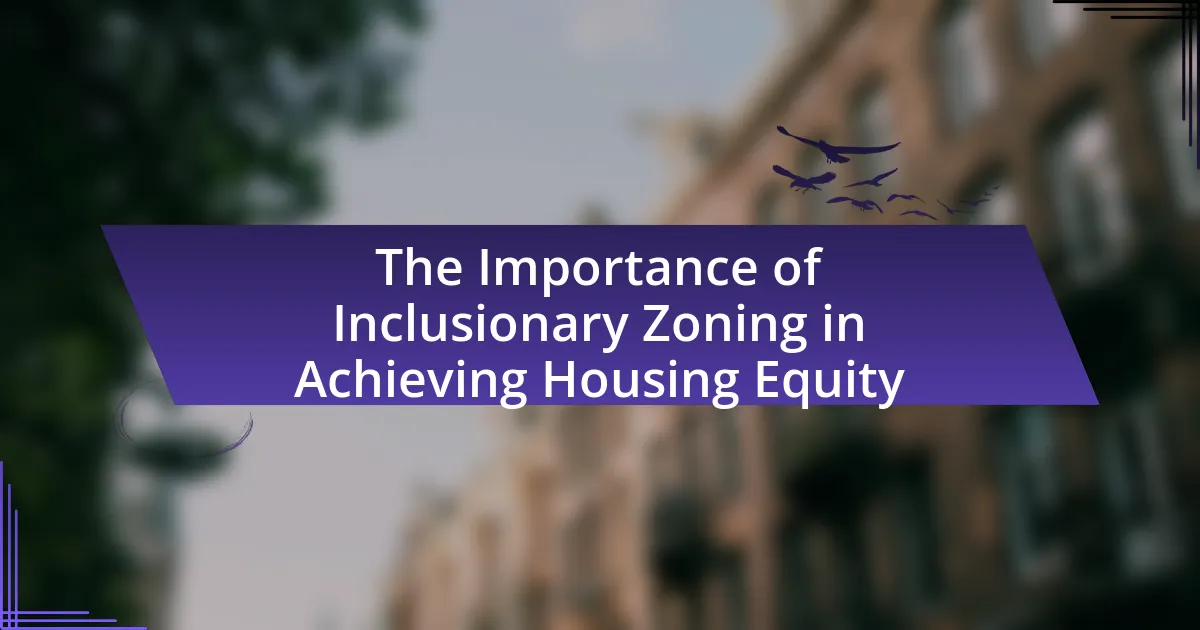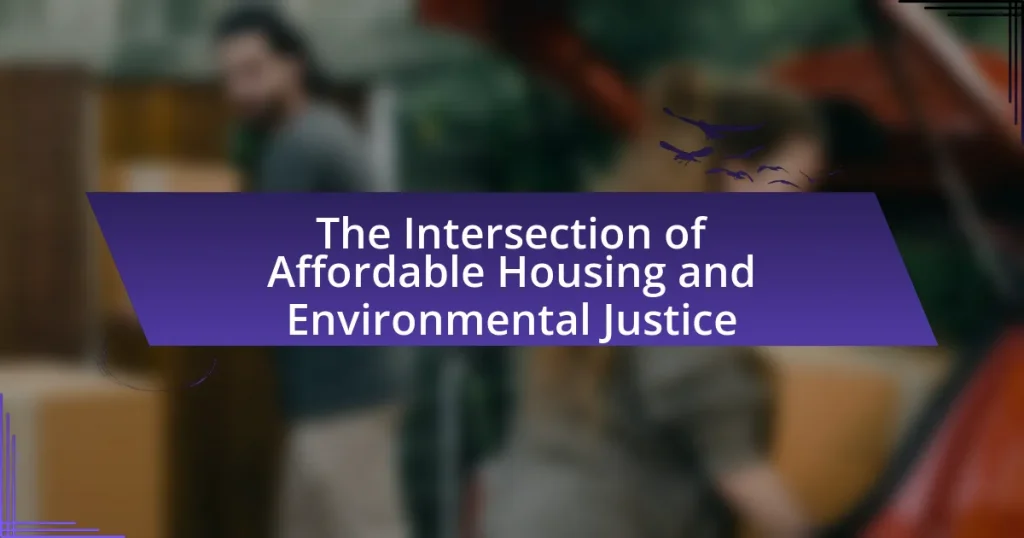Inclusionary zoning is a land-use policy that mandates or incentivizes developers to include affordable housing units in new residential developments, playing a crucial role in promoting housing equity. This policy aims to create mixed-income communities, reducing economic segregation and enhancing access to resources for low- and moderate-income families. The article explores the principles, functions, and benefits of inclusionary zoning, highlighting its effectiveness in cities like San Francisco and New York, while also addressing the challenges and best practices for successful implementation. Key topics include the impact on community demographics, the importance of public support, and strategies for overcoming barriers to ensure equitable housing access.
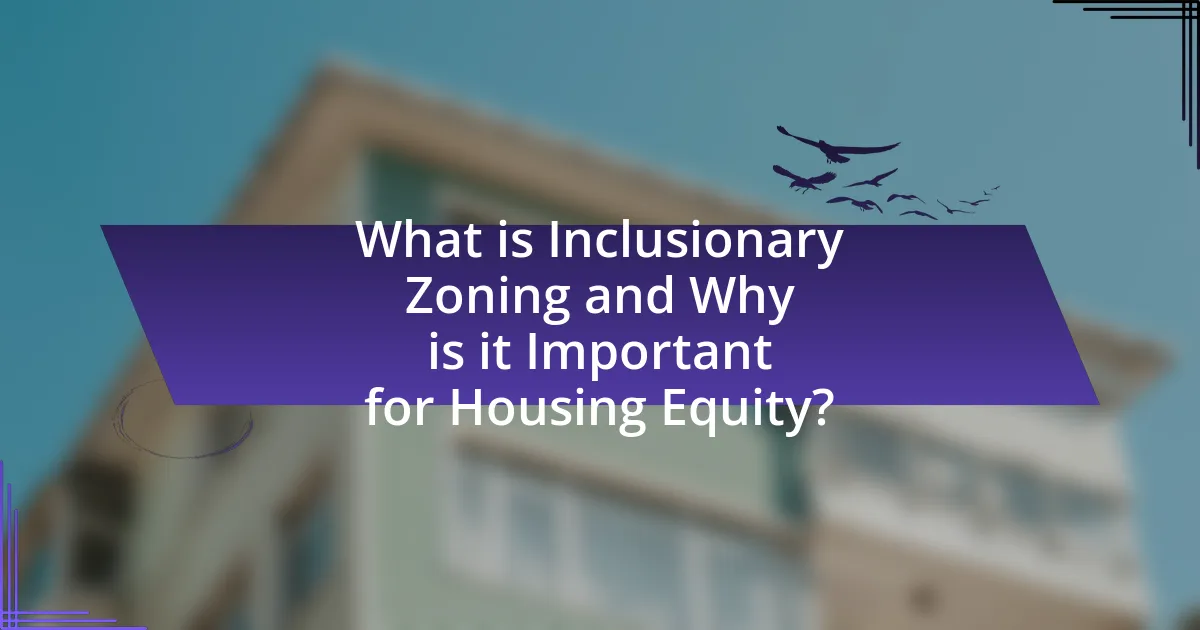
What is Inclusionary Zoning and Why is it Important for Housing Equity?
Inclusionary zoning is a land-use policy that requires or incentivizes developers to include a certain percentage of affordable housing units in new residential developments. This policy is important for housing equity because it helps to create mixed-income communities, ensuring that low- and moderate-income families have access to housing in areas with better resources and opportunities. Research indicates that inclusionary zoning can reduce economic segregation and promote social integration, contributing to overall community stability and diversity. For example, cities like San Francisco and New York have implemented inclusionary zoning policies that have resulted in thousands of affordable units being built, demonstrating its effectiveness in addressing housing inequities.
How does Inclusionary Zoning function in urban planning?
Inclusionary zoning functions in urban planning by mandating or incentivizing developers to include a percentage of affordable housing units in new residential projects. This policy aims to create mixed-income communities, thereby promoting housing equity and accessibility for low- and moderate-income households. For instance, cities like San Francisco and New York have implemented inclusionary zoning policies that require developers to allocate a portion of their units at below-market rates, effectively increasing the availability of affordable housing in high-demand areas. Studies indicate that such policies can lead to a more diverse population and reduce economic segregation, supporting the overall goal of equitable urban development.
What are the key principles of Inclusionary Zoning?
The key principles of Inclusionary Zoning include the requirement for developers to allocate a percentage of new housing units for low- and moderate-income residents, the establishment of affordability criteria to ensure that designated units remain accessible over time, and the integration of affordable units within market-rate developments to promote social diversity. These principles aim to create mixed-income communities and address housing shortages, thereby contributing to housing equity. Studies indicate that Inclusionary Zoning can increase the availability of affordable housing, with cities like San Francisco and New York implementing such policies to enhance community inclusivity and reduce economic segregation.
How does Inclusionary Zoning differ from other zoning practices?
Inclusionary Zoning differs from other zoning practices by specifically requiring a percentage of new housing developments to be affordable for low- and moderate-income residents. Unlike traditional zoning, which primarily focuses on land use and building regulations without addressing affordability, Inclusionary Zoning integrates social equity into urban planning. This practice aims to create mixed-income communities and counteract segregation, as evidenced by cities like San Francisco and New York, where Inclusionary Zoning has led to the creation of thousands of affordable units within market-rate developments.
What role does Inclusionary Zoning play in addressing housing shortages?
Inclusionary Zoning plays a critical role in addressing housing shortages by mandating that a percentage of new residential developments be affordable for low- to moderate-income households. This policy helps to increase the supply of affordable housing units in areas experiencing high demand, thereby alleviating pressure on the housing market. For instance, cities like San Francisco and New York have implemented Inclusionary Zoning policies that have resulted in thousands of affordable units being created, directly contributing to the mitigation of housing shortages.
How does Inclusionary Zoning contribute to affordable housing availability?
Inclusionary Zoning contributes to affordable housing availability by requiring developers to include a percentage of affordable units in new residential projects. This policy helps to create mixed-income communities and increases the overall supply of affordable housing options. For example, cities like San Francisco and New York have implemented Inclusionary Zoning policies that mandate developers to allocate a portion of their units for low- and moderate-income households, thereby directly addressing housing shortages and promoting equity in housing access.
What impact does Inclusionary Zoning have on community demographics?
Inclusionary Zoning significantly alters community demographics by increasing the availability of affordable housing within diverse neighborhoods. This policy encourages the integration of low- and moderate-income households into areas that may otherwise be economically homogenous, fostering socioeconomic diversity. For instance, a study by the Urban Institute found that cities implementing Inclusionary Zoning saw a 10-20% increase in affordable housing units, which directly contributed to a more varied demographic composition. Additionally, research from the National Low Income Housing Coalition indicates that such policies can reduce income segregation, promoting a more equitable distribution of resources and opportunities across different community segments.
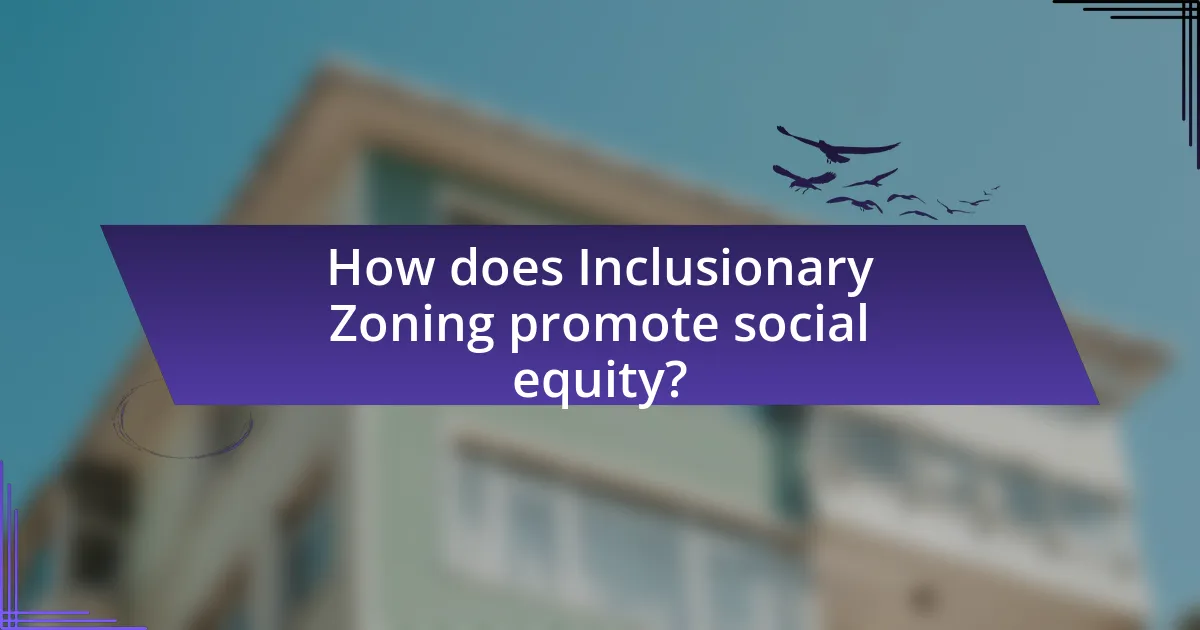
How does Inclusionary Zoning promote social equity?
Inclusionary Zoning promotes social equity by requiring developers to include affordable housing units in new residential projects. This policy helps to create mixed-income communities, which can reduce economic segregation and provide low- and moderate-income families access to better neighborhoods with essential services and opportunities. Studies show that areas with Inclusionary Zoning policies often see increased diversity and improved social cohesion, as these policies facilitate the integration of various income levels within the same community. For instance, a report by the Urban Institute found that cities implementing Inclusionary Zoning experienced a measurable increase in affordable housing availability, contributing to overall social equity.
What are the social benefits of implementing Inclusionary Zoning?
Implementing Inclusionary Zoning promotes social equity by increasing access to affordable housing for low- and moderate-income families. This policy helps to create diverse communities, reducing economic segregation and fostering social cohesion. Studies indicate that areas with Inclusionary Zoning experience improved social outcomes, such as enhanced educational opportunities and reduced crime rates, as residents from various socioeconomic backgrounds interact and support one another. Furthermore, by integrating affordable units within market-rate developments, Inclusionary Zoning encourages mixed-income neighborhoods, which can lead to better public services and infrastructure, benefiting all residents.
How does Inclusionary Zoning help reduce economic segregation?
Inclusionary Zoning helps reduce economic segregation by mandating that a percentage of new housing developments be affordable for low- and moderate-income households. This policy increases the availability of affordable housing in diverse neighborhoods, allowing economically disadvantaged individuals to reside in areas with better access to resources, such as quality schools and employment opportunities. Studies have shown that cities implementing Inclusionary Zoning have seen a rise in mixed-income communities, which fosters social integration and reduces the concentration of poverty. For example, a report by the Urban Institute found that Inclusionary Zoning can lead to a 10-20% increase in affordable housing units in targeted areas, thereby promoting economic diversity and reducing segregation.
What are the long-term effects of Inclusionary Zoning on community cohesion?
Inclusionary Zoning positively impacts community cohesion over the long term by promoting diverse, mixed-income neighborhoods. This diversity fosters social interactions among residents from various socioeconomic backgrounds, enhancing mutual understanding and reducing social isolation. Research indicates that areas with Inclusionary Zoning experience lower rates of crime and increased civic engagement, as seen in studies conducted in cities like San Francisco and New York, where mixed-income developments have led to stronger community ties and participation in local governance. These outcomes demonstrate that Inclusionary Zoning can effectively strengthen community cohesion by integrating different income groups and encouraging collaborative community dynamics.
Why is public support crucial for Inclusionary Zoning initiatives?
Public support is crucial for Inclusionary Zoning initiatives because it fosters community buy-in and ensures the successful implementation of policies aimed at increasing affordable housing. When residents advocate for Inclusionary Zoning, it can lead to more robust political backing and funding, as seen in cities like San Francisco, where public support helped pass measures that require developers to include affordable units in new projects. Additionally, strong public backing can mitigate opposition from stakeholders who may resist changes to zoning laws, thereby facilitating smoother policy adoption and enforcement.
How can community engagement enhance the effectiveness of Inclusionary Zoning?
Community engagement can enhance the effectiveness of Inclusionary Zoning by ensuring that the policies reflect the actual needs and preferences of the local population. When community members actively participate in the planning process, they provide valuable insights that can lead to more tailored and effective zoning regulations. For instance, studies have shown that areas with strong community involvement in zoning decisions often experience higher rates of affordable housing development, as local input helps identify specific housing needs and preferences. Additionally, community engagement fosters trust and collaboration between residents and policymakers, which can lead to smoother implementation of Inclusionary Zoning policies and greater overall support for affordable housing initiatives.
What strategies can be employed to educate the public about Inclusionary Zoning?
To educate the public about Inclusionary Zoning, community engagement initiatives can be employed, such as workshops, informational sessions, and public forums. These strategies facilitate direct interaction between policymakers and residents, allowing for the dissemination of clear information regarding the benefits and mechanisms of Inclusionary Zoning. Research indicates that communities with active participation in housing policy discussions are more likely to support such initiatives, as evidenced by a study from the Urban Institute, which found that informed residents are more likely to advocate for equitable housing solutions. Additionally, utilizing social media campaigns and local media partnerships can amplify outreach efforts, ensuring that diverse demographics are reached and informed about the importance of Inclusionary Zoning in promoting housing equity.
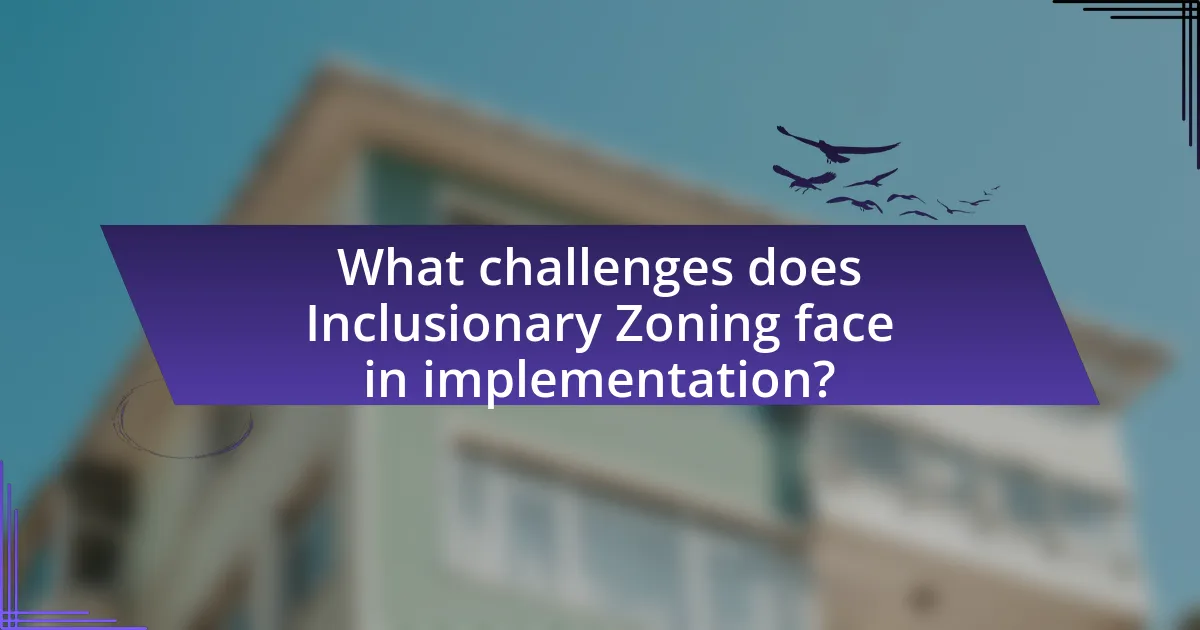
What challenges does Inclusionary Zoning face in implementation?
Inclusionary Zoning faces several challenges in implementation, primarily including political resistance, economic feasibility, and regulatory complexity. Political resistance often arises from developers and property owners who oppose mandatory affordable housing requirements, fearing reduced profits. Economic feasibility is a significant concern, as developers may struggle to balance the costs of affordable units with market-rate housing, leading to potential project cancellations. Regulatory complexity can hinder effective implementation, as varying local policies and zoning laws create inconsistencies that complicate compliance. These challenges collectively impede the successful adoption of Inclusionary Zoning, limiting its potential to enhance housing equity.
What are the common obstacles to successful Inclusionary Zoning policies?
Common obstacles to successful Inclusionary Zoning policies include political resistance, economic feasibility, and administrative challenges. Political resistance often arises from developers and local governments who may oppose regulations that limit profit margins or increase costs. Economic feasibility issues can stem from the high costs of construction and land, making it difficult for developers to incorporate affordable units without financial incentives. Administrative challenges involve the complexity of implementing and enforcing zoning regulations, which can lead to inconsistencies and inefficiencies in policy execution. These factors collectively hinder the effectiveness of Inclusionary Zoning in promoting housing equity.
How do economic factors influence the effectiveness of Inclusionary Zoning?
Economic factors significantly influence the effectiveness of Inclusionary Zoning by determining the demand for affordable housing and the financial feasibility for developers. When economic conditions are strong, such as during periods of growth, the demand for housing increases, which can lead to higher property values and rents. This scenario may incentivize developers to include affordable units in their projects, as the overall profitability can support the costs associated with compliance. Conversely, during economic downturns, reduced demand can lead to lower property values, making it less financially viable for developers to include affordable housing, thus undermining the goals of Inclusionary Zoning. For instance, a study by the Urban Institute found that in cities with robust economic growth, Inclusionary Zoning policies resulted in a higher percentage of affordable units being produced compared to cities facing economic challenges.
What legal challenges can arise with Inclusionary Zoning regulations?
Legal challenges that can arise with Inclusionary Zoning regulations include potential violations of property rights, challenges to the constitutionality of the regulations, and disputes over the adequacy of the affordable housing provisions. Property owners may argue that such regulations constitute a taking without just compensation, as seen in cases like Nollan v. California Coastal Commission, where the U.S. Supreme Court ruled that land use regulations must have a clear connection to the impact of the development. Additionally, opponents may claim that Inclusionary Zoning violates the Equal Protection Clause by disproportionately affecting certain demographics or neighborhoods. Legal disputes can also arise regarding the interpretation and implementation of the regulations, leading to litigation that can delay or complicate housing development projects.
How can policymakers overcome barriers to Inclusionary Zoning?
Policymakers can overcome barriers to Inclusionary Zoning by implementing flexible zoning regulations that accommodate diverse housing needs. This approach allows for adjustments based on local market conditions and community input, which can enhance acceptance and effectiveness. For instance, cities like San Francisco have adopted policies that provide developers with options to meet inclusionary requirements through various means, such as on-site affordable units or in-lieu fees, thereby addressing resistance from stakeholders. Additionally, providing financial incentives, such as tax breaks or grants, can encourage developers to participate in Inclusionary Zoning programs, as evidenced by successful initiatives in New York City that have increased affordable housing stock.
What best practices can be adopted to improve Inclusionary Zoning outcomes?
To improve Inclusionary Zoning outcomes, jurisdictions should adopt best practices such as establishing clear and enforceable affordability requirements, ensuring a mix of unit types, and providing incentives for developers. Clear affordability requirements, such as setting specific income thresholds, help ensure that the intended population benefits from the program. A diverse mix of unit types, including different sizes and configurations, caters to various family structures and needs, enhancing community integration. Additionally, offering incentives like density bonuses or expedited permitting can encourage developers to participate in Inclusionary Zoning programs, ultimately increasing the supply of affordable housing. These practices are supported by studies indicating that well-structured Inclusionary Zoning can lead to significant increases in affordable housing stock, thereby promoting housing equity.
How can collaboration between stakeholders enhance Inclusionary Zoning efforts?
Collaboration between stakeholders can significantly enhance Inclusionary Zoning efforts by fostering a comprehensive approach to housing equity. When government entities, developers, community organizations, and residents work together, they can identify specific local needs, share resources, and create policies that are more effective and inclusive. For instance, a study by the Urban Institute found that jurisdictions with strong stakeholder collaboration in zoning processes were able to increase affordable housing units by 25% compared to those with limited collaboration. This collaborative framework ensures that diverse perspectives are considered, leading to more equitable outcomes in housing development and access.
What practical steps can communities take to implement Inclusionary Zoning effectively?
Communities can implement Inclusionary Zoning effectively by establishing clear policies that mandate a percentage of affordable housing units in new developments. This approach ensures that developers contribute to housing equity, as seen in cities like San Francisco, where policies require 12-25% of units to be affordable based on the project’s size. Additionally, communities should engage stakeholders, including residents and developers, in the planning process to foster collaboration and address concerns. Evidence from the Urban Institute indicates that inclusive policies can lead to a more diverse community and improved economic outcomes. Furthermore, providing incentives such as density bonuses or tax abatements can encourage developers to participate in Inclusionary Zoning programs, as demonstrated in Montgomery County, Maryland, where such incentives have successfully increased affordable housing stock.
